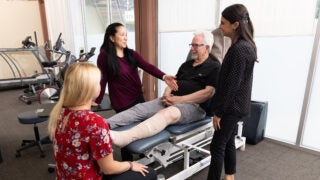USC seeks a better understanding of Alzheimer’s among Latinos
Arthur Toga joins other researchers on the five-year study backed by a $12 million grant from the National Institutes of Health
USC is taking part in a collaborative project that aims to gain a better understanding of Alzheimer’s disease among Latinos, who account for nearly 18 percent of the U.S. population, according to U.S. Census figures. A recent review estimated that only 3 percent of Alzheimer’s disease studies include Latinos in their analyses.
To help change that, the USC Mark and Mary Stevens Neuroimaging and Informatics Institute at the Keck School of Medicine of USC is teaming up with researchers from the University of North Texas Health Science Center and the University of California, San Francisco on the project called Health and Aging Brain Among Latino Elders.
“Most of the archives around the world have insufficient numbers of underrepresented groups,” said Arthur W. Toga, one of the principal investigators of the study. “It’s important for people of all races and ethnicities to participate in Alzheimer’s clinical trials because this disease is a problem that affects all of us.”
The five-year study, which is funded by a $12 million grant from the National Institutes of Health, launched in September. Investigators will recruit and test 2,000 volunteers from North Texas — half Mexican-American and half non-Hispanic white — and hope to learn something new about how the debilitating disease affects Latinos differentially.
“This is the first project specifically attempting to understand how different biological causes relate to Alzheimer’s disease across ethnicities,” said Sid O’Bryant, associate professor of internal medicine at the University of North Texas in Fort Worth, Texas and principal investigator of the study. “By looking at different potential causes related to memory loss, we may be able to target the right pathway, at the right time, with the right intervention.”
Trying to understand the disparity
The Alzheimer’s Association estimates that Latinos are 1.5 times more likely to develop Alzheimer’s disease than non-Hispanic whites, and with a growing population of elderly Latinos, researchers are eager to better understand this disparity.
O’Bryant’s previous work points to one possible explanation for Mexican-Americans’ increased risk: metabolic risk factors such as obesity and Type 2 diabetes.
It could be that diabetes and metabolic dysfunction or depression, or a combination of both, are of major importance to memory loss and Alzheimer’s disease among Mexican-Americans.
Sid O’Bryant
“It could be that diabetes and metabolic dysfunction or depression, or a combination of both, are of major importance to memory loss and Alzheimer’s disease among Mexican-Americans,” he said.
Researchers will perform cognitive tests, blood work and brain scans on participants twice during the five-year period to monitor changes in health and behavior over time. O’Bryant’s team even purchased a robot to help handle the mass of data they plan to collect: The bot will process 400,000 blood tubes stored in the university’s biorepository.
Researchers at the USC Mark and Mary Stevens Neuroimaging and Informatics Institute are responsible for another large chunk of data: 4,000 brain scans. Toga will oversee image storage and processing, while assistant professors Yonggang Shi and Meredith Braskie will process connectivity and structural images, respectively.
The recruitment stage
Investigators have begun recruiting adults aged 50 and older in North Texas, saying that one key to their approach is to study those who do not yet have Alzheimer’s.
“Once people have dementia, their brain has already undergone massive and possibly irreversible damage,” Braskie said. “It’s crucial for scientists to identify very early risk factors and their associated changes in brain measures or cognitive function. This will help us devise treatments that can prevent the onset of Alzheimer’s symptoms.”
The research is supported by the National Institute on Aging in the Institutes of Health (R01AG054073).



